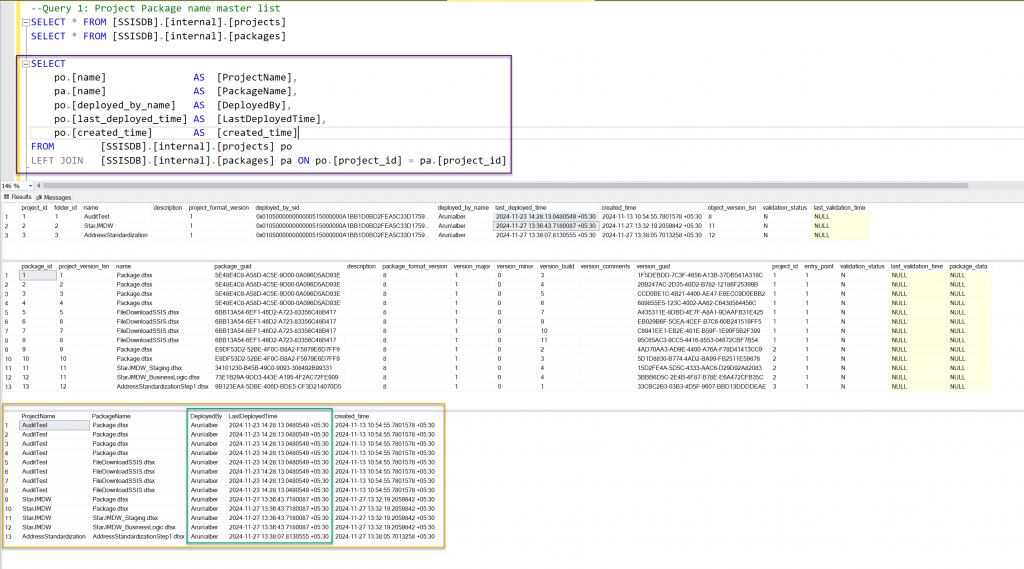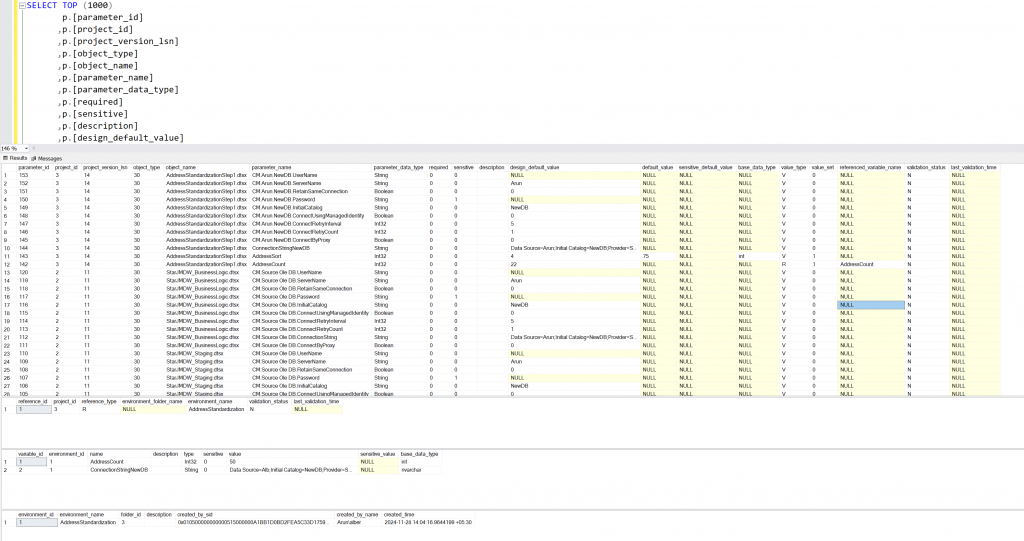Subtotal $0.00
Starting as an SSIS (SQL Server Integration Services) consultant in 2008, I quickly learned that diving into unfamiliar SSIS environments is a core part of my job. Often, clients provide limited or incorrect information about their ETL (Extract, Transform, Load) setups.
With years of experience, I’ve crafted a reliable SSIS toolkit to help quickly navigate these environments, assess existing projects, and identify opportunities for optimization. Whether you are a developer, data engineer, or team leader, these insights will help make your SSIS projects more efficient and maintainable.
Step 1: Analyzing ETL/SSIS Projects and Packages
The first task in any new SQL Server environment is to gain visibility into existing SSIS projects and packages. Understanding what’s already in place is key to assessing system health and project activity.
I start by running key T-SQL queries to extract detailed information from the SSISDB catalog. These queries provide visibility into deployed projects and SSIS packages, even if there is no formal documentation available. For example, you can run a query like this to gather a master list of SSIS projects and packages:
SELECT
po.[name] AS [ProjectName],
pa.[name] AS [PackageName],
po.[deployed_by_name] AS [DeployedBy],
po.[last_deployed_time] AS [LastDeployedTime],
po.[created_time] AS [created_time]
FROM [SSISDB].[internal].[projects] po
LEFT JOIN [SSISDB].[internal].[packages] pa ON po.[project_id] = pa.[project_id]

- Understand Naming Conventions: Are the SQL Server naming standards consistent. This gives insight into the organization’s discipline with SQL Server coding standards.
- Identify Deployment Ownership: Who deployed each SSIS projects? Understanding this helps pinpoint key technical players who are hands-on with this SSIS environment.
- When are the SSIS deployments happening, Mondays or Weekends or Fridays.
- Analyze SSIS Deployment Timelines: Compare the initial SSIS deployment date with the most recent deployment date to assess ETL project activity and lifecycle.
Key takeaway
- Project Age and Activity: Older SSIS projects with no recent deployments might be candidates for cleanup, modernization or decommissioning.
- Standards and Best Practices: Evaluate naming conventions and deployment practices to ensure consistency with SQL Server standards.
- Critical vs. Non-Critical Projects: Focus on mission-critical projects that directly impact business processes.
Step 2: Analyzing SSIS Configuration
This step offers a high-level perspective on how your team sets up SSIS packages, providing insights into the configuration philosophy and identifying areas for standardization or improvement. This is also useful for quick SSIS failure debugging or deployment review before the initial run.
Why Analyze SSIS Configuration?
Configurations determine how flexible and maintainable your SSIS packages are. By reviewing configurations, you can:
- Understand Default vs. Configured Values: Are environment variables used, or are hardcoded/default values prevalent?
- Identify Naming Conventions: How consistent is the team with variable naming (e.g., underscores, casing, plural vs. singular)?
- Spot Potential Pitfalls: Sensitive data mishandling or redundant parameters.
- SSIS failure or error debugging to check the default values vs SSIS environment variable configurations.
- Quick review for the parameter values before the run.
Red flags:
- Passwords stored in plain text.
- Repeating package parameters across various packages can be project parameters and shared across the project
- Sometimes SSIS parameters are best candidates to be stored in a table than inside SSIS package. For example, File paths, folder paths are better stored in a central FileControl table than getting spread across numerous SSIS packages. This way, its easy to make changes in a central table.
SELECT TOP (1000)
p.[parameter_id]
,p.[project_id]
,p.[project_version_lsn]
,p.[object_type]
,p.[object_name]
,p.[parameter_name]
,p.[parameter_data_type]
,p.[required]
,p.[sensitive]
,p.[description]
,p.[design_default_value]
,p.[default_value]
,p.[sensitive_default_value]
,p.[base_data_type]
,p.[value_type]
,p.[value_set]
,p.[referenced_variable_name]
,p.[validation_status]
,p.[last_validation_time]
FROM [SSISDB].[internal].[object_parameters] AS p
INNER JOIN
(
SELECT
[project_id],
MAX([project_version_lsn]) AS [Max_project_version_lsn]
FROM [SSISDB].[internal].[object_parameters]
GROUP BY [project_id]
)mp ON p.[project_id] = mp.[project_id] AND p.[project_version_lsn] = mp.[Max_project_version_lsn]
ORDER BY 1 DESC
Some additional queries to play with.
select * from [internal].[environment_references]
select * from [internal].[environment_variables]
select * from [internal].[environments]

Step 3: SSIS Errors and Warnings
This will be one of the most used query for your SSIS environment. As the title explains, this query will show you all the Errors and Warnings in the SSIS server. You can filter out warnings using the message_source_type and filter by packages or project or operation id by identifying the interested message time column. Its easier to copy paste the error message from the result to google to do further analysis on your errors.
Always keep this query handy in your SSIS tool kit for quick reference.
–Query 3 Errors and Warnings
SELECT TOP (1000)
om.[operation_id],
e.[folder_name],
e.[project_name],
e.[package_name],
om.[message_source_type],
om.[message],
om.[message_time]
FROM [SSISDB].[internal].[operation_messages] om
INNER JOIN [SSISDB].[internal].[executions] e ON om.[operation_id] = e.[execution_id]
WHERE om.[message_type] IN (110,120,130)–Warning,Error,TaskFailed
ORDER BY om.[operation_message_id] DESC

With this query, you can:
- Quickly Identify Issues: Filter errors and warnings across projects to pinpoint areas needing attention.
- Troubleshoot Efficiently: By copying error messages into Google, you can often find solutions or best practices shared by other experts.
Final Thoughts: Best Practices for Navigating New SSIS Environments
Working with SSIS environments means dealing with the unexpected. However, with a robust toolkit of T-SQL queries and best practices, you can rapidly assess and understand any SSIS setup.
As an experienced SSIS consultant, I’ve built a comprehensive SSIS toolkit that has helped dozens of clients streamline their ETL processes, reduce technical debt, and improve operational efficiency. I specialize in implementing lean, modular, and reusable SSIS templates that make troubleshooting and future development smoother and more predictable.
For more insights on best practices for SSIS and SQL Server, connect with me on LinkedIn or visit my consulting website www.utisllc.com. Let’s solve your data challenges together.



Comments are closed